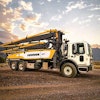
Concrete curing combines art and science, requiring close attention to detail. Just a few degrees in variation from the recommended temperature of the concrete or ambient air can affect how well the concrete cures, and the strength and durability of the finished product.
Construction sites must maintain the right conditions once the concrete has been poured, maximizing the resulting strength and minimizing the curing time. This is primarily a challenge throughout North America, where temperatures can reach extremes and fluctuate quickly.
Newly poured concrete must be maintained at the temperature the mixed supplier or structural engineer recommends to ensure optimum curing conditions. Maintaining this target temperature is a matter of mitigating temperature extremes.
What Are Remote Monitoring Systems?
A remote temperature and humidity monitoring system that uses wireless thermocouple sensors can provide contractors with real-time information on worksite conditions. The sensors are embedded in the concrete pour and placed in the surrounding area. The construction-grade sensors can perform in harsh worksite conditions and are flexible enough to be used in various projects, from the ground to the top of a skyscraper. The information from the sensors is converted into temperature data.
Monitoring systems provide contractors with up-to-the-minute temperature and humidity readings and historical cure data required for reports. They can be configured to send alerts when measurements go out of a pre-set threshold. They eliminate the labor costs of manual monitoring and free workers to perform more productive tasks.
With the systems, companies gain control of their worksites by ensuring temperatures and humidity remain at optimal levels for both crews and materials. They enable fast corrective action that prevents costly project do-overs.
 A network of remote monitoring sensors installed around the jobsite record conditions like temperature, humidity, concrete maturity, and ground thaw. All data is compiled in an app so contractors can make better decisions.United Rentals
A network of remote monitoring sensors installed around the jobsite record conditions like temperature, humidity, concrete maturity, and ground thaw. All data is compiled in an app so contractors can make better decisions.United Rentals
Key Monitoring System Components
Here are the critical remote monitoring system components that make it easy for contractors to have the information they need when they need it.
- Remote temperature monitoring via a device of choice - Monitoring systems must allow contractors to measure remotely and record temperature and humidity levels from the solution’s dashboard via a computer, smartphone or tablet. The system should support monitoring a jobsite on a room-by-room and floor-by-floor basis. That’s a significant advantage when a contractor is trying to maintain an optimal temperature in the basement to get concrete to cure, while at the same time protecting the expensive wood paneling in the penthouse-level boardroom.
- Custom alerts to enable immediate response - Contractors need the ability to access real-time temperature and humidity data at any hour of the day or night. They should be able to set notifications that alert them via text or email when levels exceed the pre-set parameters.
These alerts identify the problem’s nature and pinpoint the sensor’s or sensors’ location that triggered the alert. They let contractors take immediate action to ensure that the concrete curing proceeds properly. - Make temperature adjustments remotely - Knowing when the temperature gets too high or low is helpful, but remote temperature monitoring can’t eliminate all late-night trips to the jobsite to make heater adjustments. Work crews could find themselves climbing up and down stairs in the cold and dark to turn heaters on or off in various rooms at various levels.
Smart heater devices attached to rented construction heaters can be integrated with monitoring systems to allow contractors to adjust each thermostat via the monitoring system’s dashboard remotely. This reduces fuel waste and can decrease the heaters a jobsite needs. - Maintain precise records - It can be valuable to have a record of past concrete temperatures for quality records and to provide recourse in case of a dispute resolution scenario. Concrete temperature data logging may also be required – particularly for infrastructure projects.
Remote Monitoring Improves Concrete Curing Processes
Contractors must take advantage of every tool and technology that can help them work smarter and more efficiently. A remote monitoring system when curing concrete can shrink schedules and save man-hours. Even more important, it provides contractors and project owners confidence in the quality and strength of concrete placements.




















